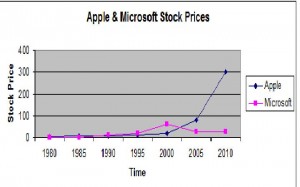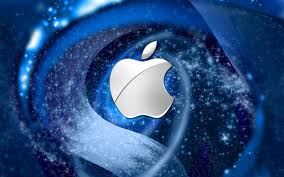“Microsoft sells different flavors of soda. Apple sells water, coffee, tea, beer, wine, vodka, cheese, meats, breads, … and it also sells soda.”
Stock Price and Corporate Valuations
On Oct. 28, 2010, Apple closed at 305.24, about 4% below its the historic high of 319, reached on October 18, 2010. Apple’s earnings per share, EPS, is $15.15. It’s price earnings ratio, P/E, is 20.147. It’s market capitalization is $279.59 Billion.
That same day, Microsoft closed at $26.28, at 45% of it’s historic high of 57.625, reached on 12/17/1999. Microsoft’s EPS is 2.11, P/E ratio is 12.48, and market capitalization is $227.42 Billion, $52 Billion less than that of Apple.
If you look at a graph of their stock prices, Microsoft climbed spectacularly from 1986 to 1999, then plummeted and has been basically flat since it crashed in 2000. Apple climbed much more slowly, until recently, and may still be rising. However, while the graph may tell one thousand words, it doesn’t tell the whole story. And there are two flaws:
- The graph is an approximation of the stock price of AAPL and MSFT from the period of 1980 to 2010. It is neither complete, detailed, or rigorous. Complete details can be found on the Internet. The graph shows that Microsoft grew during the ‘80’s and ‘90’s then spiked dramatically and crashed around 2000. Actual high point was Dec. 17, 1999. The low of 21 reached on Dec. 29, 2000. Apple was doing pretty badly during the ‘90’s, however, since Steve Jobs return in the mid to late 90’s turned around. The stock price increased to 100 in 2007 or 2008 to 318 earlier this month.
- The graph doesn’t show the increase in market capitalization. An investment in Microsoft of about $3,000 at the IPO in March, ’86 would have been worth about $1.0 Million at the peak in Dec. ’99, and would still be worth about $455,000 today, an increase of 15,200%. Apple and Microsoft went from Million-Dollar companies in the early 1980s to companies worth $280 and $227 Billion, respectively today.
But perhaps the real insight is to view of these curves from a systems thinking perspective. Is the Microsoft stock price curve an example of overshoot and collapse? Will it recover or has it reached a steady state? Is Apple peaking? Is it about to collapse? Will it drop, and stabilize, like Microsoft, to a point less than half of it’s peak? And if so, if not now, when?
OS X, Windows 7, Windows 2008 Server
A quick glance at computers running Microsoft Windows 7 and Apple OS X show a superficial resemblance between the operating systems and other software. Both are graphical user interfaces that can run similar applications software, including Microsoft Office, Sun / Oracle Open Office, Microsoft Internet Explorer (ver. 5.0 and earlier on the Mac), Mozilla Firefox, Apple Safari, Google Chrome and iTunes. However, Microsoft Windows 7 is more like it’s predecessors Microsoft Windows Vista, XP, 2000, and NT than its distant cousins, OS X (and Linux).
There are three current editions of Windows 7; “Windows 7 Home,” priced at $119.99, “Windows 7 Professional” priced at $199.99, and “Windows 7 Ultimate”, priced at $219.99.And there are seven editions of Windows 2008 Server, named: “Enterprise”, “Datacenter”, “Standard”, “Itanium”, “Web”, “Foundation”, and “HPC”. These range in price from about $300 to about $3000, depending on the size of the institution, whether it is an educational institution, a non-profit, or a for-profit corporation. That’s 10 Different Current Editions of MS Windows!
There are Two Different Current Editions of Apple OS X; one for the laptop / desktop, and one for the server.
The second best thing about Windows 7 is that it uses less memory and crashes less frequently than Windows Vista.It is not surprising that this is not highlighted on the Microsoft web-site. However, the best thing about Windows 7, according to a friend of mine who uses it, is the voice-to-speech software – you can use a microphone to dictate into your PC, and it translates what you’ve stated into a text file, or commands. I could have dictated this document. Rather than type “microsoft.com” people can say “microsoft dot com”. It’s just like “Star Trek“. This is great for people who can’t type. Yet it is not discussed on Microsoft’s own web site highlighting the “great” features of the product.
A computer running Microsoft Windows needs “Professional” or “Ultimate” to work in a corporate “domain.” A computer running Microsoft Windows in a home or college setting can run “Windows 7 Home.” However, this paper discusses the stock prices and corporate strategies of Apple and Microsoft; it does not focus on the different editions of their Operating Systems.
Strategies
De Wit & Meyer, in Strategy Synthesis, wrote “Adding a lemon-flavoured Coke to the product portfolio is interesting, maybe important, but not a stretegic change, while branching out into bottled water was – it was a major departure from Coca-Cola’s traditional business system”
Apple’s mission statement seems to be “Explore the way people use information processing technology. Develop new ways to do things. Focus on the user interface. Think Different!” Thus they observed that a simple technology for storing audio files, the mp3 file, was being used by the technically hip to store and swap copies of songs. By building a better “mousetrap” and integrating the iPod with iTunes software – which they give away – Apple became the biggest music publisher on the planet. The iPod/iTunes system also drove sales of iMacs. Children in middle school and high school own iPods. When faced with the Mac v PC decision, when, for example, they go off to college, many naturally choose Mac rather than PCs.
In the 80’s and ’90’s Microsoft made four strategic moves.
- Write a graphical user interface – Windows, circa ’86, two years after Apple introduced the Mac, and three years after Apple introduce the Lisa.
- Integrate their word processor, spreadsheet, and e-mail software Word, Excel, and Outlook, into a bundled product, MS Office, and integrate it with Windows.
- Develop a “Back-Office Suite,” which is basically composed of MS SQL Server, a database manager like Oracle, MS Exchange, an E-Mail system, add an e-mail component to Office, and a couple of other technologies, such as Active Directory, designed to facilitate use of SQL server and Exchange.
- Aug. 6, 1997, Microsoft invested $150 Million in Apple, in return for non-voting shares.
Moves 1 and 2 gave Microsoft a very strong leg up on the competition – Word Perfect, WordStar, for word processing and Lotus 1-2-3 for spreadsheets. Why learn three user interfaces when all you really needed to learn is one user interface, more or less, because each have the same basic command structure? Move 3 and advanced “server-class” computers from Compaq, Dell, HP, IBM, gave Microsoft the ability to compete with Oracle, Sybase, Informix databases and versions of Unix from HP and Sun. Move 4, according to Wired, “breathe[d] new life into a [then] struggling Silicon Valley icon.” (http://www.wired.com/thisdayintech/2009/08/dayintech_0806/). For the next few years, because of sales of Office and the different margins on hardware and software, Microsoft made more money than Apple with the sale of each Mac. Writers in the blogosphere contend that the investment also supported Microsoft’s contention that it was not a monopolist since it enabled a competitor to survive.
But lately, Microsoft doesn’t seem to have done much other than protect its profits, and profits of $4 Billion on revenues of $14.5 Billion are pretty good, and should be protected, and protect its share of the market, as they should, given the size of the market and Microsoft’s share. Bill Gates and Steve Ballmer may have read “Sun Tsu, The Art of War” but they appear to be focused on protecting their flank, If they are digging Maginot Lines, Apple is flying over and circumventing the lines with lower total costs of ownership on the iMac (they don’t crash often, they are not as suseptible to viruses as Windows machines) and with things like iPods, iPhones, iPads, iTunes, the App Store, and other new things – which drive sales of iMacs.
Microsoft just announced that the new version of MS Office for the Mac will have a functioning version of the Outlook e-mail software application. This supports my hypothesis that Microsoft is protecting its flank: thinking “people are buying Macs, they are buying Office for the Mac, they need our email software.” It will also facilitate the integration of Macs into the corporate world.
Meanwhile, the Apple iPad … doesn’t have a keyboard, a hard drive, or any moving parts. It will run for about 25 hours on a full charge. It will display documents, spreadsheets, images, presentations, and of course, e-mail and web-pages – it is a perfect device for salespeople, consultants, and people who want to read books, newspapers, browse the web, check their e-mail, and do all sorts of other information oriented work and play. It is probably water resistant. It is the perfect device for salespeople or consultants. It will also facilitate the integration of Macs into the corporate world.
So in terms of strategy, Microsoft sells different flavors of soda. Apple sells water, coffee, tea, beer, wine, vodka, cheese, meats, breads, fruits, vegetables … and it also sells soda.
– Notes
- Bob deWit, Ron Meyer, Strategy Synthesis: Resolving Strategy Paradoxes to Create Competitive Advantage, Cengage Learning Business Press; 3 edition (April 9, 2010), ISBN: 978-1408018996
- “Apple, the New Microsoft,” by Henry Blodget, 8/31/09, Business Insider, http://www.businessinsider.com/henry-blodget-apple-the-new-microsoft-2009-8
- “Apple stock rise could have meant $4.5 Billion for Microsoft,” by Chris Foresman, ARS Technica, http://arstechnica.com/microsoft/news/2010/05/apples-stock-rise-could-have-meant-5-billion-for-microsoft.ars
- “Microsoft’s equity in Apple”, Justin Hartman, 11/23/07, http://justinhartman.com/2007/11/23/microsofts-equity-in-apple/
- “This Day In Tech, 8/6/97”, but John C. Abel, Wired, on 8/6/09, http://www.wired.com/thisdayintech/2009/08/dayintech_0806/
- Stock data on Google Finance: Apple: http://www.google.com/finance?q=aapl, Microsoft: http://www.google.com/finance?q=msft
- Microsoft Web Page describing the edition of Windows 7: http://www.microsoft.com/windows/windows-7/compare/versions.aspx
- Microsoft Web Page describing the editions of Windows 2008 Server. : http://www.microsoft.com/windowsserver2008/en/us/r2-compare-roles.aspx


